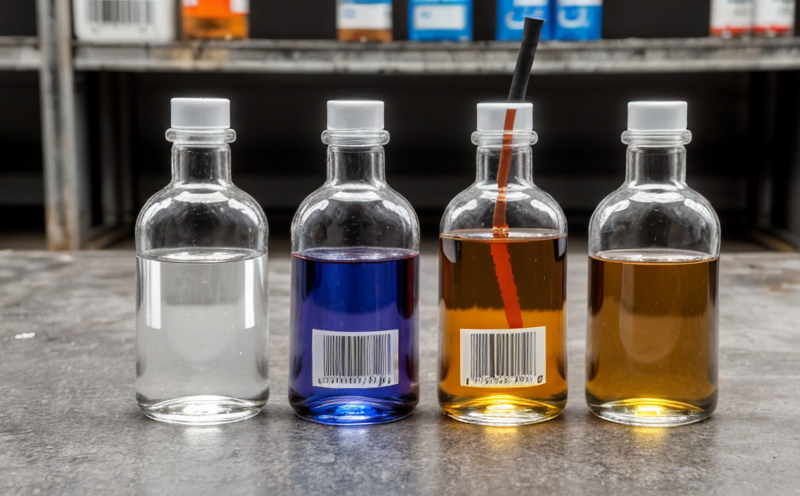ISO 3380 Leather Chemical Stability Testing
The ISO 3380 standard is a critical tool used in the leather industry to evaluate the chemical stability of tanned leather. This test ensures that the leather will maintain its physical and aesthetic properties under exposure to various chemicals, which are often encountered during processing, storage, or use.
Leather undergoes numerous stages before it can be made into finished products such as footwear, clothing, and furniture. Each step involves chemical treatments aimed at enhancing durability, appearance, and functionality. However, prolonged contact with these chemicals can lead to degradation of the leather over time. The ISO 3380 test helps manufacturers identify potential issues early in the development process by simulating real-world conditions that could cause degradation.
The testing protocol involves placing tanned leather specimens into a solution containing common chemicals used in leather production and processing, such as acids, bases, salt solutions, and various solvents. The samples are then incubated at controlled temperatures for specified durations. After the exposure period, the stability of the leather is assessed through visual inspections and mechanical strength tests.
One of the key aspects of this test is its ability to predict long-term performance by accelerating potential degradation processes. This allows manufacturers to optimize their production methods and select appropriate chemical treatments that enhance durability without compromising on quality or appearance.
In addition to evaluating general stability, ISO 3380 also helps in assessing the impact of specific chemicals commonly used in leather processing. For instance, it can identify whether particular acids or alkalis have a detrimental effect on the integrity of the finished product. Such insights are invaluable for R&D departments as they strive to create innovative yet sustainable products.
The results from ISO 3380 testing play a crucial role in ensuring compliance with international standards and regulations, thereby protecting both consumer safety and environmental sustainability. By adhering to these tests, manufacturers not only meet regulatory requirements but also build trust among consumers by delivering high-quality, reliable products.
Furthermore, the data obtained from ISO 3380 testing provides valuable information for quality control teams responsible for maintaining consistent product standards across different batches and production lines. This ensures that every batch of leather produced meets the expected levels of chemical resistance and stability, which is essential in industries where uniformity is critical.
For procurement departments involved in sourcing raw materials or components intended for use in leather goods manufacturing, this test offers assurance regarding the compatibility and durability of these materials. It helps them make informed decisions about suppliers based on demonstrated performance metrics rather than mere specifications.
Why It Matters
The importance of ISO 3380 Leather Chemical Stability Testing cannot be overstated, especially in today’s competitive market where brand reputation and customer satisfaction are paramount. By adhering to this standard, manufacturers demonstrate their commitment to delivering products that meet stringent quality benchmarks.
- Consumer Trust: A consistent record of passing ISO 3380 tests enhances consumer confidence in the durability and longevity of leather goods.
- Regulatory Compliance: Meeting international standards ensures compliance with legal requirements, reducing potential risks associated with non-compliance penalties.
- Sustainability: Understanding how different chemicals affect leather helps minimize waste by preventing premature deterioration during use.
- Innovation: Insights gained from ISO 3380 testing enable manufacturers to innovate new treatments that enhance both the performance and environmental impact of their products.
In conclusion, ISO 3380 Leather Chemical Stability Testing serves as a cornerstone for ensuring high-quality leather products while fostering trust among consumers and meeting regulatory expectations. Its role in promoting sustainability and driving innovation underscores its significance in contemporary manufacturing practices.
Applied Standards
The ISO 3380 standard is part of a broader family of standards that govern various aspects of leather processing, including chemical stability. It aligns closely with other international guidelines such as ASTM D473-19 and EN 16546:2018.
ASTM D473-19 focuses on the mechanical properties of tanned leathers exposed to water, which complements ISO 3380 by providing additional insights into how leather withstands moisture exposure. Meanwhile, EN 16546:2018 deals with the physical and chemical characteristics of chrome-tanned leather used in footwear, further reinforcing the importance of maintaining stability under diverse conditions.
By incorporating these standards into their quality assurance processes, manufacturers can ensure comprehensive coverage across all relevant parameters affecting leather performance. This holistic approach enhances reliability and consistency in product offerings, ultimately contributing to greater customer satisfaction.





